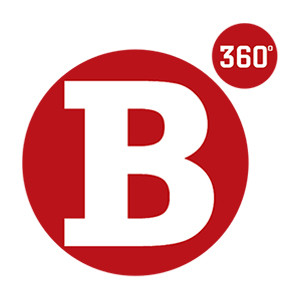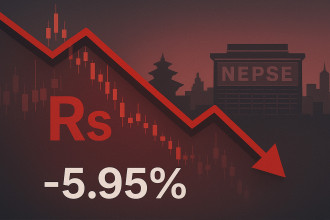
The Nepal Stock Exchange (NEPSE) index rose by 95.57 points (+3.59%), closing at 2,760.80 points on July 13, up from 2,665.23 on June 12. Over this period, the index experienced a dip in late June, bottoming out near 2,556 before staging a strong recovery in early July. This rebound drove the market to new near-term highs, reflecting renewed investor optimism and improved buying momentum.
Compared to the previous review period, which had seen significant trading activity, this phase reflected a more measured yet positive sentiment, with investors cautiously returning to the market. The U-shape movement of the index indicates early consolidation followed by confident upward traction, pointing toward a potentially bullish market in the short term. (See Figure 1)
-1754914537.jpg)
Throughout the review period, two of the 11 sub-indices ended in the red zone, while the remaining nine posted gains. Commercial Bank, Microfinance and Development Bank sub-indices led the gains, while Hydropower and Trading sectors dragged overall performance.
Commercial Bank sub-index (+10.43%) was the biggest gainer as the share value of Siddhartha (+Rs 63.26), NIC Asia (+Rs 57.69) and Everest (+Rs 54.8) increased substantially. Microfinance sub-index (+8.77%) followed witnessing a rise in share prices of Samudayik Laghubitta (+Rs 307.97), Mahila Laghubitta (+Rs 208.59) and Unique Nepal Laghubitta (+Rs 186.04).
Development Bank sub-index (+4.89%) followed suit with increase in the share value of Green (+Rs 134.46), Saptakoshi (+Rs 46.63) and Excel (+Rs 35.67). Similarly, Finance sub-index (+4.06%) rose with Nepal Finance (+Rs 130.6), Manjushree Finance (+Rs 30.6) and Goodwill Finance (+Rs 29.19) going up. Likewise, Life Insurance sub-index (+2.84%) witnessed a rise in the share prices of Prabhu Mahalaxmi (+Rs 29.49), Nepal Life (+Rs 28.71) and Reliable Nepal (+Rs 26.52).
Non-Life Insurance sub-index (+2.81%) also rose with positive movements in Rastriya Beema (+Rs 531.62), Prabhu (+Rs 107.63) and Shikhar (+Rs 38.03). Manufacturing and Processing sub-index (+1.84%) saw gains from Bottlers Nepal (Balaju) (+Rs 829.8), Bottlers Nepal (Terai) (+Rs 130) and Himalayan Distillery (+Rs 40.67). Others sub-index (+1.18%) also gained supported by Pure Energy (+Rs 132.37), Nepal Warehousing (+Rs 34.77) and Nepal Reinsurance (+Rs 22.15). The Hotels and Tourism sub-index (+0.80%) also posted a slight gain, driven by Chandragiri Hills (+Rs 32.64), City Hotel (+Rs 30.14) and Taragaon Regency (+Rs 23.47).
On the downside, Trading sub-index (-2%) was weighed down by Bishal Bazar Company (-Rs 140.93), although Salt Trading Corporation (+Rs 278.57) posted a gain. Hydropower sub-index (-2.99%) was the worst performer over the review period, with losses in the share prices of Peoples Power (-Rs 96.01), Mid-Solu (-Rs 86.51) and Dordi Khola Jal Bidyut (-Rs 83.01).
-1754980288.jpg)
News and Highlights
This review period saw notable regulatory and structural developments in Nepal’s capital market. On June 23, the Ministry of Finance, acting on a recommendation made over a year ago by the Commission for the Investigation of Abuse of Authority (CIAA), directed SEBON to thoroughly assess the financial and managerial health of companies before granting approvals, aiming to strengthen oversight and due diligence mechanisms.
Meanwhile, SEBON amended the Securities Issuance and Distribution Directive, first introduced in 2008, through its ninth revision, allowing banks and financial institutions to issue non-cumulative preference shares to institutional investors. This update is intended to ease capital adequacy requirements and support credit growth.
On policy reform, SEBON’s chairperson reaffirmed his commitment to issuing a new stock exchange licence and restructuring NEPSE, noting the absence of legal barriers to progress. During his July 10 address to the Finance Committee, he emphasised the need for coordinated efforts among SEBON, NEPSE and the government, calling for inclusive and balanced capital market growth.
In addition, SEBON also revised IPO regulations for investment companies, introducing stricter requirements including a minimum paid-up capital of Rs 500 million, profitability for two consecutive years, investment in productive sectors, and a higher credit rating threshold.
Despite governance concerns, including conflict-of-interest allegations related to SEBON’s approval of Bungad Hydropower’s Rs 290.5 million IPO on June 29, the primary market remained active. Four companies issued IPOs during this period. Mabilung Energy (Hydropower), managed by Laxmi Capital Market, was listed on June 15. Following that, Swastik Laghubitta Bittiya Sanstha (Microfinance), managed by Nabil Investment Banking, was listed on June 19. Bungad Hydropower (Hydropower), managed by Himalayan Capital, followed on June 29. Most recently, Bandipur Cable Car and Tourism (Hotels and Tourism), managed by Nepal SBI Merchant Banking, was listed on July 3.
Together, these developments reflect an active market and a regulator moving toward tighter controls and broader structural reforms.
Outlook
The recent rise in NEPSE reflects improving investor confidence, led by the banking and microfinance sectors. If this momentum continues, the market may see increased activity and stability. Upcoming regulatory changes, such as stricter IPO rules, market oversight, and the potential launch of a new stock exchange, along with the anticipation of favourable monetary policy, could strengthen the market over time. Meanwhile, these shifts may also bring short-term uncertainty.
As Nepal’s capital market enters a phase of reform, investors are advised to follow market trends closely and focus on strong, fundamentally sound companies. With effective implementation, these reforms could lead to a more transparent, efficient and resilient market environment.
This is an analysis from beed Management. No expressed or implied warranty is made for the usefulness or completeness of this information, and no liability will be accepted for the consequences of actions taken based on this analysis.






